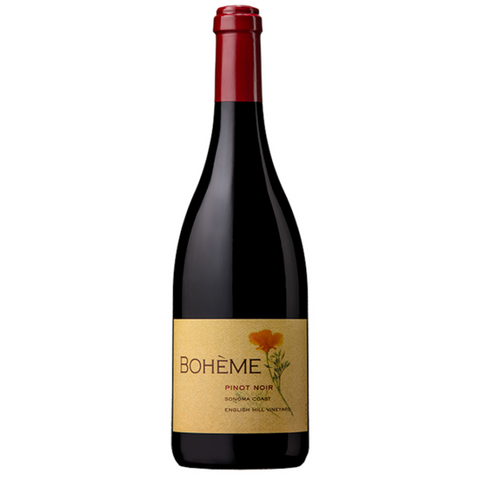
2019 Boheme "English Hill Vineyard" Pinot Noir, Sonoma Coast, California, USA
Bohème's broadest and most savory Pinot Noir expression: brick-hued with earthen, fermented aromas including mushroom, fennel, and red fruits and fresh cut grass; palate of coriander, brown spice, dried cherry and alfalfa
There are 2 units left in stock.
ABOUT THIS WINE
English Hill Vineyard grows at the southwest edge of Sebastopol Hills, surrounded by expansive pasture and rangeland. Overlooking Russian River Valley and the Marin Coast, weather swings wildly between continental and maritime influences.
2019 Pinot Noir: Five clones of Pinot Noir are planted at this site that bridges Sonoma Coast and Russian River Valley growing regions. The grapes were harvested between September 14th to 25th with an average yield of 2.42 tons per acre. English Hill Pinot Noir received tailored cold-soak and hand punch-down treatment with 25% Whole Cluster fermentation. The wine aged 22 months in 20% new French Burgundy barrels before bottling.
ABOUT THIS PRODUCER
Driving the backroads of the southern Sonoma Coast, Beitler has his trio of leased vineyards, all windy and poor-soiled (both qualities excellent for making lower-alcohol, balanced Pinot Noirs and Chardonnays).
Bohème produces only about 1,500 cases per vintage, and that’s in a good year on the perpetually rugged coast. His troika of vineyards (soon to be four)—English Hill, Taylor Ridge and Stuller— produce grapes with somewhat disparate attributes derived from their particular terroir. For instance, while grapes from one might contribute salty, licorice flavors, others may be more floral and grapes grown on the third might display more fruit or less acidity.
Beitler maintains a style that keeps the wines in check—no trifle, given the often-harsh conditions the coastal terrain bestows, which at once can be damning and a blessing. That is, they are exquisitely flowery, delicate on the palate and always have spritely acids that are as brisk as they are cleansing. Bohème Chardonnays and Pinot Noirs are in the 13.5 to 14.3% alcohol range—low by California standards. When conditions bring lots of rain, cold and searing winds, the fruit can hold back its sweet delights, thereby elevating the acid levels to puckery-ness. But in the hands of a sensitive soul such as Beitler, the results can be gorgeous.
Part of the beauty of growing grapes close to the ocean, he explains, is that there’s a long growing season without accumulating sugars fast, and the wines are able to maintain complexity. “There’s a lot of pressure on New World producers for explosiveness, and Pinot Noir is no exception. Many take great pains to darken the wines, concentrate the flavors, soften the acidity.”
